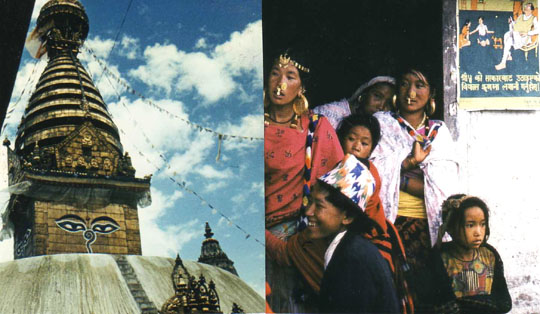Apr 20, 2024
Apr 20, 2024
by Satis Shroff
Nepalese men and women work in the fields. They use the traditional bullocks and buffaloes that are seen in the villages of Southeast Asia. As you start for the temple, you're first greeted by two Tibetan lions, set in stone, amid wonderful wooded surroundings. Behind the lions you see three colossal statues of the Buddha, serene and daubed in flaming red and gold. All around you there are naked trees in poses of suspended animation.
They dig the fields manually. The women work beside the men, with babies strapped to their backs. Long wooden hoes are being used to dig and break the soil, whole families pitching in to do the job. And far out in the distance, the all-seeing-eyes of the compassionate Swayambhu observes the land from the towers on which his eyes are painted.
The ground crackles as you step on the fallen brown and russet leaves. Shrill bird cries ring through the air. It is roosting time, you say to yourself. The trees are silhouetted against the evening sky and the shadows are lengthening. Your eyes discern the prayers carved in the granite slabs as you ascend the seemingly endless stairs.
A bearded tourist and a bevy of girls giggle nearby, talking in French and eating peanuts. They pass some peanuts to the swarm of monkeys who are a regular feature of Swayambhu. The Rhesus monkeys are creeping, jumping, fooling and fighting with each other.
"How happy they are", remarks a tourist with a laugh, as the monkeys climb the spire of the stupa. The overhanging eaves of the stupa, gilded with gold, are loosely chained together. The wind blowing from across the silvery Himalayas makes them rustle. You are dumbfounded by the majestic temple.
Three lamas go by: "Om mane padme hum" stirs in the air.
You take a cue from them and go about spinning the 211 copper prayer wheels that girdle the dome. Then you peer at the all-seeing-eyes painted on the four sides of the stupa and look where they look: at the myriad pale yellow, white, blue and crimson lights of the Kathmandu Valley below. You feel that you have indeed reached the top of the world.
It is chilly, and an icy gust of wind blows your hair. The clatter of the prayer-wheels is constant. The stony stairs are set at an extremely steep angle, but there are railings to help you up or down. A Tibetan, probably a Khampa from Eastern Tibet, mumbles his prayers as he comes down from the temple. He is wrapped in heavy mauve woollens. A shaggy Tibetan Apso, a tiny dog, like a Pekingese, with bells round his collar jingles past.
You go on. A few paces up, a monkey stealthily passes by as though he were a big-game hunter. You are again confronted by meditating Buddhas: the Dhyanibuddha Akshobya who rides an elephant and a lion, Ratnasambhava who rides a horse, Amitabha who rides the peacock and Amoghasiddhi who rides the heavenly bird garuda.
The going is hard but the ascent is redeemed because of the breathtaking beauty of the place. More Rhesus monkeys dart around you. One of them takes a joy ride along the railings like a kid, skids off and vanishes. You can't help laughing. You abruptly come across two statues of horses: short and stubby. You're weary but you press on and come across small elephant statues, with live monkeys playing pranks on their backs. The monkeys give you a quizzical stare. These are all part of the Buddhist pantheon. Now you begin to understand why the tourists call this temple complex also "the monkey temple". The monkeys are protected by law (as is the yeti) and have freedom there since over 2000 years. They live on the offerings brought by the Hindus and Buddhists, and peanuts and popcorn offered by the tourists.
Your climb is over. The sky is dark, blue, and is fast changing into Prussian blue, and Venus has already appeared, but you have eyes only for the gigantic white dome and stupa of the Self-Existent One. The stupa is of great sanctity for all Hindus and Buddhists. It is hemispherical and you are struck by its enormous size. The earliest inscription on Swayambhunath dates back to the year 1129, but the stupa is thought to be much older.
You make your way to a Buddhist monk and he tells you a legend about Swayambhu...
"Once upon a time the Nepal Valley was a great lake. It was on this spot, where you now stand that a lotus bloomed and became the heart of the world."
31-Mar-2007
More by : Satis Shroff